Land-use decision making offers a unique avenue for historical analysis – in Stratford, Ontario, as elsewhere
This post features images of work in progress at the Tom Patterson Theatre Centre, in parkland adjacent to the Avon River in Stratford, Ontario.
The Festival Theatre, where (under a canvas tent) the Stratford Festival was launched in 1953, is also located on riverside parkland, east of Tom Patterson Centre.
The parkland along the Avon River is the outcome of a history of land-use decision making with close involvement of Stratford residents, going back many years before launch of the festival.
Storytelling and cultures and histories of land-use decision making are of much interest to me. At this post I will share some reflections about such topics.
For decades I have stayed away from archival research because, as a freelance writer, I’ve found it easier to engage in storytelling – that is, to reach a reading audience and keep readers awake – by basing my texts on interviews rather than on archives. After many years, however, I’ve come to realize that access to archives does not preclude great storytelling. It took me a while to come around to this.
Every five years, as I’ve heard one actor (Sheila McCarthy) say, it’s a great idea to re-invent yourself.
It was a veteran actor who told Sheila McCarthy this secret to success. I read about this at an online article about McCarthy’s connections to the Stratford Festival. It’s taken me more like fifty years to re-invent myself.
I knew Sheila McCarthy’s father Dermot McCarthy quite well through my volunteer work. I learned many things talking with him. He was closely attuned to Canada’s cultural scene; he was in touch with many key players. He was also a talented watercolour painter.
Over many years – in Toronto and later in Guelph – he shared many anecdotes and observations with me about painting, photography, music, writing, and cultural and business-related topics of all kinds including about Stratford, and the movie business, which I was always most interested to learn about.
Dermot McCarthy had the capacity to vividly describe situations and personalities in just a few words. Although I did not realize it at the time, conversations with him, spread out over many years, were a most informative, and valuable, ongoing seminar.
I was intrigued that Dermot, as a result of his own life experiences and lifelong social milieu, associated certain personas or character types with certain types of achievements. As I look back, I reflect upon the fact that on occasion, spectacular and unexpected things are accomplished by personas that may appear quite low-key.
Tom Patterson, a key player in launch of the Stratford Festival in 1953, comes to mind – a low-key persona, viewed in his early years as “just a dreamer” by some observers, who in the course of his life accomplished amazing things. I’ve heard an anecdote that, when he was a Grade 4 student in Stratford, Tom Patterson would often be looking out the window, instead of attending to what his teacher was saying. Patterson had a dream – and he also had the drive to turn a dream into a reality.
Strong footing makes the going easier
Recently, we re-installed a handrail (old handrail, new brackets) on stairs leading to second floor of our house in Stratford. The house is over a hundred and ten years old. I don’t know how old the handrail is. It may be as old as the house, or not.
After the re-installation, each time I walk up and down the stairs and use the handrail, I think about the metaphorical qualities associated such strong means of support. Handrails denote:
Strength: A properly installed handrail is going to be strong. Its strength is among its key features.
Readily evident function: A handrail helps a person maintain stability while moving. Having something solid to lean can be a big plus. A good handrail will be of a width, and sometimes with features, such as a rounded top cross-section, that makes it easy to grasp. I’ve seen awkward handrails to which more user-friendly, secondary handrails have been attached, thereby making them more useful. The features of handrails indicate the amount of thought that has gone into their design.
Finite dimensions: Unlike some other things, such as historical epochs by way of example – where the start and finish may be indefinite – a handrail has a clear beginning and ending.
Self-contained system: A handrail is a self-contained system. The brackets that attach the handrail to studs on a wall have to be correctly positioned, in order for the handrail to work. The brackets also have to be positioned at a suitable height, so that a person can use the device. When all parts are well positioned, the handrail works well.
So, having thought about the handrail, I can now make it a practice to look at anything in my field of view and decide how that item works, with respect to the qualities such as strength; function; dimensions; and systemic coordination or the lack of it. I can also look at events and processes (such as political events and processes) and can analyze them, on those terms.
Here’s my quick analysis, by way of illustration, of the concept of land-use decision making as an avenue for historical analysis:
The concept is strong in that it covers a lot of ground and serves as a useful lens; it is functional; its general dimensions are pretty vague (a quality that I like) – the vagueness can be addressed through precision in definition of terms and great care with regard to language usage when employing the concept; it’s a self-contained system, which is useful up to a point – that is, you don’t want to set up a tautology, and you can’t expect that such a concept is going to explain everything.
Land use
I’ve recently begun to do archival research in Stratford related to launch of the Stratford Festival in 1953, for an article and a book chapter I am working on. I have found it most interesting to realize that “land-use decision making” (or maybe it’s “land use decision making” – that is, without a hyphen; that remains to be seen) is a category of analysis that is not about to pop up for somebody, if they wish to proceed with archival research.
That is to say, the researcher is the person who is going to bring the suitable conceptual framework, that will be used to engage in storytelling on the basis of whatever of value and significance a person is able to track down in archives.
I have until now avoided archives, as I have preferred to build stories based on interviews, or to rely on archival research by people who specialize in such research.
As a blogger, in recent years I’ve begun to think about land-use decision making as a concept. During the twenty-one years we lived in Long Branch in Toronto, I became intrigued, for example, with the concept that cultures of land-use planning are decidedly different, in different municipalities across Ontario.
By way of example, in my anecdotal observation the link between rhetoric and reality, with regard to citizen engagement in urban planning, is much more robust in cities such as Mississauga than it is, for example, in Toronto. That tends to be consistently evident, in my anecdotal experience over a decade of observation, in tone and tenor of public meetings at which residents and planners (and occasionally developers) take part.
In a neighbourhood such as Long Branch in Toronto, it’s been my experience that when the tone gets contentious at such meetings, a point routinely arrives when city planners choose to abruptly shut discussion down, meaning that topics of interest to many residents remain festering and unaddressed.
I can’t picture such a scenario routinely unfolding in Mississauga. In that city, by way of contrast, the tone does not as a rule get overwhelmingly contentious, and discussion proceeds respectfully and productively.
Consider the power dynamics, as observed anecdotally by a particular reporter, in this case me. In one setting (Mississauga), planners are not really in a position to shut down a debate; in another setting (South Etobicoke) planners are in a position to shut it down – and, in fact, are in a position (as I’ve highlighted regarding an April 2018 meeting) to temporarily mislead a person (that being me) into believing that recording of what planners say is not permitted, without prior permission from the city’s media department.
As well, in Port Credit and Lakeview developers tend to actually turn up at such public meetings, and are listened to (and, in return listen) respectfully. As a rule, developers are absent at similar meetings in, for example, Long Branch.
I was also intrigued, in the twenty-one years we lived in Long Branch, to learn that cultures of land-use decision making – at the Ontario Municipal Board over the past twenty-five and more years, for example – can change dramatically over time.
A related topic that interests me is the constitutional arrangement in place in Canada, dating back to 1867, with regard to power dynamics, related to land-use decision making, between provinces and municipalities. In such an arrangement, municipalities are “creatures” of the province. Such an arrangement strikes an observer, by which I mean an observer such as myself among many others, as a can of worms.
An additional related topic – related to among other things the relation between rhetoric and reality in context of power dynamics – is language usage. For example, “neighbourhood character” means different things depending on which side of which metaphorical fence you have positioned yourself. As well, a distinct rhetoric is in place (and warrants close analysis) with reference to exchange of pejorative terms (terms in use, in a particular instance, serving a strategic emotive purpose, contingent on where a person is coming from) related to land use.
Seeing Like a State (1998) and Transformation of the World (2014)
Given that I’ve also been reading extensively about military history and colonial history over the past decade, I’ve determined that concepts related to land-use decision making can be explored at vast scales. You don’t just need to look at land use as seen at the local level, wherever you happen to be living.
One can, for example, look at land-use concepts within the context of global history of the nineteenth century, as outlined in a study such as The Transformation of the World: A Global History of the Nineteenth Century (2014) by Jürgen Osterhammel.
Among land-use decisions that Osterhammel highlights at length, for example, is the manner in which Indigenous peoples in frontier regions “were decimated or reduced to poverty while constitutional democracies were taking shape there for the first time” (p. 368) during the nineteenth century. “Frontiers may thus,” the author notes, “be sites of archaic violence as well as birthplaces of political and social modernity.”
James C. Scott in Seeing Like a State: How Certain Schemes to Improve the Human Condition Have Failed (1998) has similarly explored weighty topics – topics of strong relevance which can, in my view, be analyzed from the perspective of land-use decision making.
Scott describes, for example, what has happened in some cases when nation-states have sought to oversimplify data analysis as it relates to land usage, with disastrous results.
As an online blurb for his 1998 study notes, Scott identifies and discusses four conditions common to all planning disasters, of the nature that I refer to: “administrative ordering of nature and society by the state; a ‘high-modernist ideology’ that places confidence in the ability of science to improve every aspect of human life; a willingness to use authoritarian state power to effect large-scale interventions; and a prostrate civil society that cannot effectively resist such plans.”
Both of the above-noted studies – by Jürgen Osterhammel and James C. Scott – have vastly increased my own understanding of how questions related to land use have been addressed in history, and how they are being addressed now.
History of land use in Stratford
At the remainder of this post, I will outline my current view of how questions related to history of land use in Stratford can be addressed. As a newcomer to Stratford, I have the benefit of a fresh perspective, as a naive and untutored observer.
My general topic concerns the transformation of Stratford from a faltering industrial centre (having been dependent upon what was becoming a disappearing railway industry) to theatre-focused tourist destination (where new forms of manufacturing have also been introduced).
An article I am working on focuses on the launch of the Festival Theatre and its park setting, and also includes other Stratford heritage buildings that have been repurposed as theatres. These are great topics for archival research at the Stratford Festival Archive and the Stratford-Perth Archive.
The article will include archival and/or recent photos.
I’m also writing a book focusing on the history of successful community-oriented land-use projects in Ontario, such as (in some cases) in South Etobicoke, (in more frequent cases) in Mississauga along the Lake Ontario waterfront, and also in Stratford. One chapter will be devoted to launch of the Stratford Festival in 1953.
Topics of interest for current writing project
Here is an overview of topics of interest:
1. I’m interested in history of development of the parks system in Stratford starting around the late 1800s along the Avon River, which helped set the stage for building of the Festival Theatre along the parkland in the 1950s
2. Also of interest is land-use decision making guided by R. Thomas Orr in the early 1900s to keep a railway line from being built along the Avon River, a key factor in sustaining the parks system as an ideal location, for launch of the Stratford Festival. I have read a quote (in a recently published book about Thomas Orr) in which Tom Patterson speaks of Orr as a person – capable of getting things done on behalf of the Stratford community – who served as a source of inspiration for him.
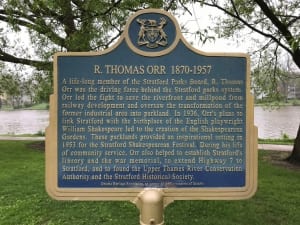
Plaque by Avon River highlighting the contribution of Robert Orr to development of the Stratford parks system. Jaan Pill photo
3. As well, I’m keen to learn more about 1980s land-use decisions related to the Ballantyne textile business between North St. and Front St. north of Ballantyne Ave.; I’ve interviewed long-time local residents who describe a successful community effort (around the 1980s, if I recall correctly from interviews) to keep a big hotel from being built at the site; instead two condos were built which have worked out well.
4. The history of the heritage building at 210 Water St. at foot of Trow Ave. is of interest. As I understand from speaking with local residents, an OMB hearing some years ago scuttled a planned development at the site; neighbours had objected that such a development would not fit with physical character of the neighbourhood.
5. I’m interested in the history of deindustrialization in Stratford starting in the 1950s when the Cooper Lot was closed down; this set the stage for a drive led by Tom Patterson to launch the Stratford Festival as an alternative economic opportunity.
6. I’m interested in the history related to the repurposing of the building that now houses the Avon Theatre in Stratford. I’m also interested in the history of related repurposing projects.
7. I’m interested in what is known about Indigenous land use (in the general area where Stratford is now located) in the pre-settlement era when several Indigenous civilizations were developed along the Great Lakes. Until recent times it’s been a feature of settler history in Southwestern Ontario that tracking down information in this area is a most interesting challenge. I am aware from what I have learned to date in exploring First Nations history in the Greater Toronto Area that I must turn, with regard to history of Indigenous land use, to the historical information that is available directly from Indigenous sources.

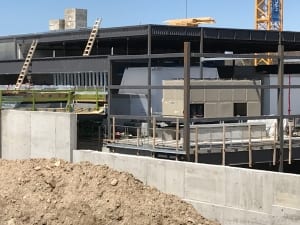
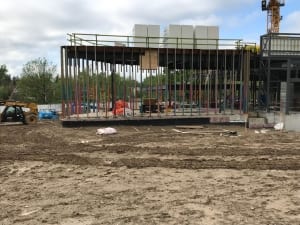
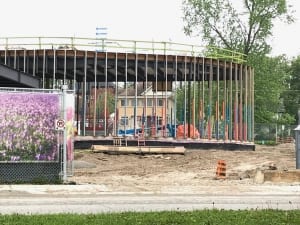
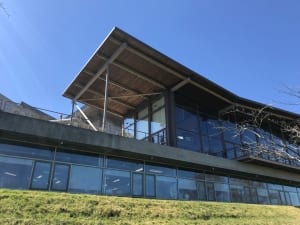
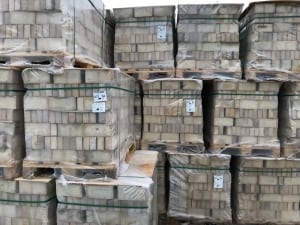
Leave a Reply
Want to join the discussion?Feel free to contribute!